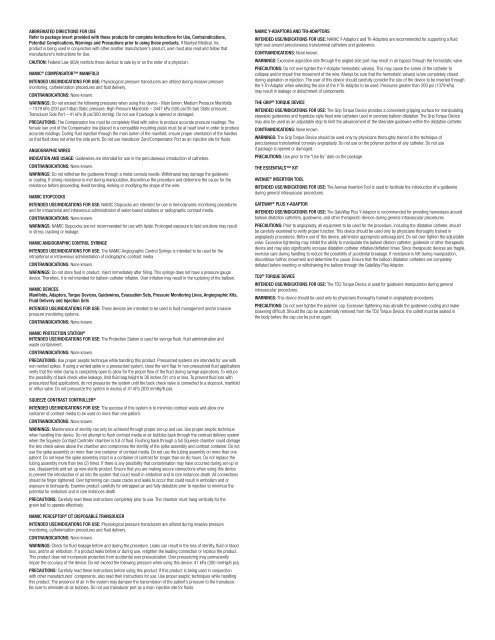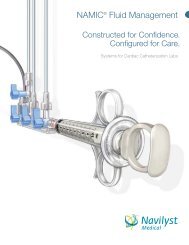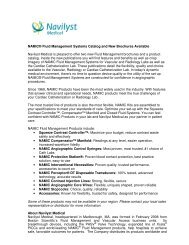Fluid Management Catalog - Navilyst Medical
Fluid Management Catalog - Navilyst Medical
Fluid Management Catalog - Navilyst Medical
Create successful ePaper yourself
Turn your PDF publications into a flip-book with our unique Google optimized e-Paper software.
ABBREVIATED DIRECTIONS FOR USE<br />
Refer to package insert provided with these products for complete Instructions for Use, Contraindications,<br />
Potential Complications, Warnings and Precautions prior to using these products. If <strong>Navilyst</strong> <strong>Medical</strong>, Inc.<br />
product is being used in conjunction with other another manufacturer’s product, user must also read and follow that<br />
manufacturer’s Instructions for Use.<br />
CAUTION: Federal Law (USA) restricts these devices to sale by or on the order of a physician.<br />
NAMIC ® COMPENSATOR MANIFOLD<br />
INTENDED USE/INDICATIONS FOR USE: Physiological pressure transducers are utilized during invasive pressure<br />
monitoring, catheterization procedures and fluid delivery.<br />
CONTRAINDICATIONS: None known.<br />
WARNINGS: Do not exceed the following pressures when using this device - Main lumen: Medium Pressure Manifolds<br />
– 1379 kPa (200 psi/14bar) Static pressure; High Pressure Manifolds – 3447 kPa (500 psi/35 bar) Static pressure;<br />
Transducer Side Port – 41 kPa (6 psi/300 mmHg). Do not use if package is opened or damaged.<br />
PRECAUTIONS: The Compensator line must be completely filled with saline to produce accurate pressure readings. The<br />
female luer end of the Compensator line (placed in a compatible mounting plate) must be at heart level in order to produce<br />
accurate readings. During fluid injection through the main lumen of the manifold, ensure proper orientation of the handles<br />
so that fluid does not enter the side ports. Do not use transducer Zero/Compensator Port as an injection site for fluids.<br />
ANGIOGRAPHIC WIRES<br />
INDICATION AND USAGE: Guidewires are intended for use in the percutaneous introduction of catheters.<br />
CONTRAINDICATIONS: None known.<br />
WARNINGS: Do not withdraw the guidewire through a metal cannula needle. Withdrawal may damage the guidewire<br />
or coating. If strong resistance is met during manipulation, discontinue the procedure and determine the cause for the<br />
resistance before proceeding. Avoid bending, kinking or modifying the shape of the wire.<br />
NAMIC STOPCOCKS<br />
INTENDED USE/INDICATIONS FOR USE: NAMIC Stopcocks are intended for use in hemodynamic monitoring procedures<br />
and for intraarterial and intravenous administration of water-based solutions or radiographic contrast media.<br />
CONTRAINDICATIONS: None known.<br />
WARNINGS: NAMIC Stopcocks are not recommended for use with lipids. Prolonged exposure to lipid solutions may result<br />
in stress cracking or leakage.<br />
NAMIC ANGIOGRAPHIC CONTROL SyRINGE<br />
INTENDED USE/INDICATIONS FOR USE: The NAMIC Angiographic Control Syringe is intended to be used for the<br />
intraarterial or intravenous administration of radiographic contrast media.<br />
CONTRAINDICATIONS: None known.<br />
WARNINGS: Do not store fluid in product. Inject immediately after filling. This syringe does not have a pressure gauge<br />
device. Therefore, it is not intended for balloon catheter inflation. Over inflation may result in the rupturing of the balloon.<br />
NAMIC DEVICES<br />
Manifolds, Adaptors, Torque Devices, Guidewires, Evacuation Sets, Pressure Monitoring Lines, Angiographic Kits,<br />
<strong>Fluid</strong> Delivery and Injection Sets<br />
INTENDED USE/INDICATIONS FOR USE: These devices are intended to be used in fluid management and/or invasive<br />
pressure monitoring systems.<br />
CONTRAINDICATIONS: None known.<br />
NAMIC PROTECTION STATION ®<br />
INTENDED USE/INDICATIONS FOR USE: The Protection Station is used for syringe flush, fluid administration and<br />
waste containment.<br />
CONTRAINDICATIONS: None known.<br />
PRECAUTIONS: Use proper aseptic technique while handling this product. Pressurized systems are intended for use with<br />
non-vented spikes. If using a vented spike in a pressurized system, close the vent flap. In non-pressurized fluid applications<br />
verify that the roller clamp is completely open to allow for the proper flow of the fluid during syringe aspirations. To reduce<br />
the possibility of back check valve leakage, limit fluid bag height to 36 inches (91 cm) or less. To prevent fluid loss with<br />
pressurized fluid applications, do not pressurize the system until the back check valve is connected to a stopcock, manifold<br />
or reflux valve. Do not pressurize the system in excess of 41 kPa (300 mmHg/6 psi).<br />
SqUEEzE CONTRAST CONTROLLER ®<br />
INTENDED USE/INDICATIONS FOR USE: The purpose of this system is to minimize contrast waste and allow one<br />
container of contrast media to be used on more than one patient.<br />
CONTRAINDICATIONS: None known.<br />
WARNINGS: Maintenance of sterility can only be achieved through proper set-up and use. Use proper aseptic technique<br />
when handling this device. Do not attempt to flush contrast media or air bubbles back through the contrast delivery system<br />
when the Squeeze Contrast Controller chamber is full of fluid. Flushing back through a full Squeeze chamber could damage<br />
the two check valves above the chamber and compromise the sterility of the spike assembly and contrast container. Do not<br />
use the spike assembly on more than one container of contrast media. Do not use the tubing assembly on more than one<br />
patient. Do not leave the spike assembly intact in a container of contrast for longer than six (6) hours. Do not replace the<br />
tubing assembly more than two (2) times. If there is any possibility that contamination may have occurred during set-up or<br />
use, disassemble and set up new sterile product. Ensure that you are making secure connections when using this device<br />
to prevent the introduction of air into the system that could result in embolism and in rare instances death. All connections<br />
should be finger tightened. Over tightening can cause cracks and leaks to occur that could result in embolism and or<br />
exposure to biohazards. Examine product carefully for entrapped air and fully debubble prior to injection to minimize the<br />
potential for embolism and in rare instances death.<br />
PRECAUTIONS: Carefully read these instructions completely prior to use. The chamber must hang vertically for the<br />
green ball to operate effectively.<br />
NAMIC PERCEPTOR ® DT DISPOSABLE TRANSDUCER<br />
INTENDED USE/INDICATIONS FOR USE: Physiological pressure transducers are utilized during invasive pressure<br />
monitoring, catheterization procedures and fluid delivery.<br />
CONTRAINDICATIONS: None known.<br />
WARNINGS: Check for fluid leakage before and during the procedure. Leaks can result in the loss of sterility, fluid or blood<br />
loss, and/or air embolism. If a product leaks before or during use, retighten the leading connection or replace the product.<br />
This product does not incorporate protection from accidental over pressurization. Over pressurizing may permanently<br />
impair the accuracy of the device. Do not exceed the following pressure when using this device: 41 kPa (300 mmHg/6 psi).<br />
PRECAUTIONS: Carefully read these instructions before using this product. If this product is being used in conjunction<br />
with other manufacturers’ components, also read their instructions for use. Use proper aseptic techniques while handling<br />
this product. The presence of air in the system may dampen the transmission of the patient’s pressure to the transducer.<br />
Be sure to eliminate all air bubbles. Do not use transducer port as a main injection site for fluids.<br />
NAMIC y-ADAPTORS AND TRI-ADAPTORS<br />
INTENDED USE/INDICATIONS FOR USE: NAMIC Y-Adaptors and Tri-Adaptors are recommended for supporting a fluid<br />
tight seal around percutaneous transluminal catheters and guidewires.<br />
CONTRAINDICATIONS: None known.<br />
WARNINGS: Excessive aspiration rate through the angled side port may result in air bypass through the hemostatic valve.<br />
PRECAUTIONS: Do not over tighten the Y-Adaptor hemostatic valve(s). This may cause the lumen of the catheter to<br />
collapse and/or impair free movement of the wire. Always be sure that the hemostatic valve(s) is/are completely closed<br />
during aspiration or injection. The user of this device should carefully consider the size of the device to be inserted through<br />
the Y-Tri-Adaptor when selecting the size of the Y-Tri-Adaptor to be used. Pressures greater than 200 psi (1379 kPa)<br />
may result in leakage or detachment of components.<br />
THE GRIP ® TORqUE DEVICE<br />
INTENDED USE/INDICATIONS FOR USE: The Grip Torque Device provides a convenient gripping surface for manipulating<br />
steerable guidewires and hypotube style fixed wire catheters used in coronary balloon dilatation. The Grip Torque Device<br />
may also be used as an adjustable stop to limit the advancement of the steerable guidewire within the dilatation catheter.<br />
CONTRAINDICATIONS: None known.<br />
WARNINGS: The Grip Torque Device should be used only by physicians thoroughly trained in the technique of<br />
percutaneous transluminal coronary angioplasty. Do not use on the polymer portion of any catheter. Do not use<br />
if package is opened or damaged.<br />
PRECAUTIONS: Use prior to the “Use By” date on the package.<br />
THE ESSENTIALS KIT<br />
AVENUE ® INSERTION TOOL<br />
INTENDED USE/INDICATIONS FOR USE: The Avenue Insertion Tool is used to facilitate the introduction of a guidewire<br />
during general intravascular procedures.<br />
GATEWAy ® PLUS y-ADAPTOR<br />
INTENDED USE/INDICATIONS FOR USE: The GateWay Plus Y-Adaptor is recommended for providing hemostasis around<br />
balloon dilatation catheters, guidewires, and other therapeutic devices during general intravascular procedures.<br />
PRECAUTIONS: Prior to angioplasty, all equipment to be used for the procedure, including the dilatation catheter, should<br />
be carefully examined to verify proper function. This device should be used only by physicians thoroughly trained in<br />
angioplasty procedures. Before use of this device, administer appropriate anticoagulant. Do not over tighten the adjustable<br />
valve. Excessive tightening may inhibit the ability to manipulate the balloon dilation catheter, guidewire or other therapeutic<br />
device and may also significantly increase dilatation catheter inflation/deflation times. Since therapeutic devices are fragile,<br />
exercise care during handling to reduce the possibility of accidental breakage. If resistance is felt during manipulation,<br />
discontinue further movement and determine the cause. Ensure that the balloon dilatation catheters are completely<br />
deflated before inserting or withdrawing the balloon through the GateWay Plus Adaptor.<br />
TD2 ® TORqUE DEVICE<br />
INTENDED USE/INDICATIONS FOR USE: The TD2 Torque Device is used for guidewire manipulation during general<br />
intravascular procedures.<br />
WARNINGS: This device should be used only by physicians thoroughly trained in angioplasty procedures.<br />
PRECAUTIONS: Do not over tighten the polymer cap. Excessive tightening may abrade the guidewire coating and make<br />
loosening difficult. Should the cap be accidentally removed from the TD2 Torque Device, the collett must be seated in<br />
the body before the cap can be put on again.








